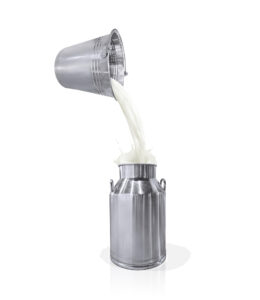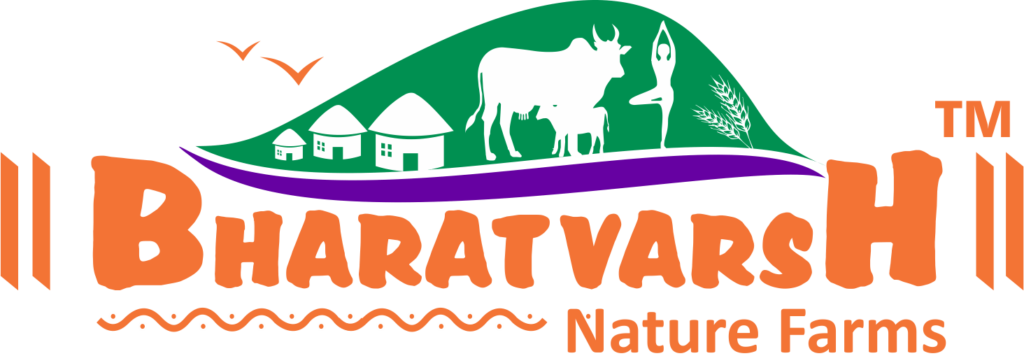As the sun blazes down on the rolling fields of Bharatvarsh Nature Farms, dairy farmers face a challenge that’s as old as agriculture itself: keeping their cows cool and comfortable in swelteringly unbearable heat. Heat stress in dairy cattle isn’t just a minor inconvenience-it’s a significant threat to animal health, milk production, and farm profitability. For farmers in hot climates, finding effective heat stress solutions for livestock is critical to maintaining a thriving dairy operation. In this comprehensive guide, we’ll dive deep into the causes, effects, and practical solutions for heat stress in dairy cattle, offering actionable hot weather dairy farming tips to help farmers like you beat the heat.
At Bharatvarsh Nature Farms, we’ve seen firsthand how rising temperatures can impact livestock. Our mission is to empower farmers with knowledge and tools to ensure their herds stay healthy and productive, no matter how high the mercury climbs. From dairy cow heat stress management to innovative cooling systems for dairy farms, we’re here to share best practices for dairy farming in hot climates that can transform your operation.
Understanding Heat Stress in Dairy Cattle
Heat stress in dairy cattle occurs when cows are unable to dissipate body heat effectively, leading to physiological strain. Dairy cows are particularly vulnerable because their large bodies generate significant heat during digestion and milk production. When ambient temperatures exceed 25°C (77°F) with high humidity, cows struggle to cool themselves, resulting in heat stress in dairy cattle.
The effects of heat on milk production are profound. Studies show that milk yield can drop by 10-25% during heat stress, with high-producing cows being the most affected. Beyond reduced milk output, heat stress in dairy cattle can lead to reproductive issues, weakened immunity, and even mortality in severe cases. For farmers in hot climates, the climate impact on dairy cattle is a pressing concern that demands proactive dairy cow heat stress management.
At Bharatvarsh Nature Farms, we’ve observed that heat stress in dairy cattle isn’t just about temperature-it’s about humidity, airflow, and the cow’s overall environment. That’s why our approach to heat mitigation in cattle focuses on holistic solutions that address these factors comprehensively.
The Effects of Heat on Milk Production

Let’s talk numbers. The effects of heat on milk production are stark. A cow experiencing heat stress in dairy cattle may produce less milk, with fat and protein content often declining as well. This directly impacts a farmer’s bottom line. For instance, a 10% reduction in milk yield for a herd of 100 cows producing 30 liters daily translates to a loss of 300 liters per day-a significant financial hit.
Moreover, heat stress in dairy cattle affects reproductive efficiency. Heat-stressed cows show delayed estrus, reduced conception rates, and increased embryonic loss. This means fewer calves and a longer calving interval, further straining farm economics. The climate impact on dairy cattle also extends to feed intake, as cows eat less during hot weather, leading to energy deficits that exacerbate milk production losses.
At Bharatvarsh Nature Farms, we’ve worked with farmers to implement heat stress solutions for livestock that mitigate these issues. By focusing on summer care for dairy cows, we’ve helped farms maintain milk yields and protect herd health even during the hottest months.
Recognizing Signs of Heat Stress in Dairy Cattle
Before diving into solutions, it’s crucial to recognize the signs of heat stress in dairy cattle. Cows don’t sweat like humans, so they rely on panting and seeking shade to cool off. Here are key indicators:
- Increased respiration rate: Cows may pant rapidly, with rates exceeding 60 breaths per minute.
- Reduced feed intake: Heat-stressed cows eat less, leading to weight loss and lower milk production.
- Lethargy: Affected cows may appear sluggish or spend more time lying down.
- Decreased milk yield: A sudden drop in milk production is a red flag.
- Reproductive issues: Irregular estrus cycles or failure to conceive are common.
Farmers at Bharatvarsh Nature Farms are trained to monitor these signs closely, ensuring early intervention to prevent heat stress in dairy cattle from escalating. By catching these symptoms early, you can implement dairy cow heat stress management strategies to protect your herd.
Heat Stress Solutions for Livestock: Practical Strategies
Tackling heat stress in dairy cattle requires a multi-faceted approach. Below, we outline best practices for dairy farming in hot climates, drawing on our experience at Bharatvarsh Nature Farms to offer hot weather dairy farming tips that work.
1. Optimize Cooling Systems for Dairy Farms
Investing in cooling systems for dairy farms is one of the most effective ways to combat heat stress in dairy cattle. These systems create a comfortable environment, allowing cows to maintain normal body temperatures. Here are some options:
- Fans and ventilation: High-velocity fans improve air circulation in barns, reducing humidity and heat buildup. At Bharatvarsh Nature Farms, we recommend installing fans in milking parlors and resting areas to enhance heat mitigation in cattle.
- Misters and sprinklers: Sprinkler systems that wet the cow’s skin, paired with fans, promote evaporative cooling. These are particularly effective in dry climates.
- Shade structures: Providing ample shade is non-negotiable. Portable shade cloths or permanent roofs over feeding and resting areas protect cows from direct sunlight.
Our team at Bharatvarsh Nature Farms has seen milk yields stabilize after installing cooling systems for dairy farms, proving their value in dairy cow heat stress management.
2. Enhance Summer Care for Dairy Cows
Summer care for dairy cows goes beyond cooling systems. Adjusting management practices can significantly reduce heat stress in dairy cattle. Consider these hot weather dairy farming tips:
- Adjust feeding schedules: Feed cows during cooler parts of the day, such as early morning or late evening, to encourage intake. High-energy diets can also offset reduced feed consumption.
- Provide clean water: Cows drink 10-20% more water during hot weather. Ensure unlimited access to clean, cool water to prevent dehydration.
- Modify milking times: Milking during the hottest part of the day can exacerbate heat stress in dairy cattle. Shift milking to cooler hours to minimize stress.
At Bharatvarsh Nature Farms, we’ve implemented these summer care for dairy cows strategies, resulting in healthier cows and more consistent milk production.
3. Improve Housing and Environment
The design of your dairy facility plays a critical role in preventing heat stress in cows. Poorly ventilated barns or overcrowded pens can amplify heat stress in dairy cattle. Here’s how to optimize housing:
- Increase airflow: Open-sided barns or ridge vents improve ventilation, reducing heat buildup.
- Reduce stocking density: Overcrowding increases competition for shade and water, worsening heat stress in dairy cattle. Ensure adequate space per cow.
- Use reflective roofing: Light-colored or reflective roofing materials lower barn temperatures, enhancing heat mitigation in cattle.
Bharatvarsh Nature Farms has helped farmers retrofit barns with these features, creating environments that support dairy cow heat stress management.
4. Monitor and Manage Herd Health
Regular health checks are vital for preventing heat stress in cows. Work with a veterinarian to monitor herd health and address issues promptly. Key actions include:
- Track respiration rates: Regularly check cows for signs of panting, a key indicator of heat stress in dairy cattle.
- Supplement electrolytes: Adding electrolytes to water can help cows maintain hydration and mineral balance.
- Vaccinate and deworm: Heat stress weakens immunity, making cows more susceptible to disease. Keep vaccinations and parasite control up to date.
Our farmers at Bharatvarsh Nature Farms prioritize herd health, ensuring heat stress solutions for livestock include proactive veterinary care.
5. Leverage Technology for Heat Mitigation in Cattle
Modern technology offers innovative tools for dairy cow heat stress management. From wearable sensors to automated cooling systems, technology can streamline heat stress solutions for livestock. Examples include:
- Cow wearables: Sensors that monitor respiration, activity, and body temperature can alert farmers to early signs of heat stress in dairy cattle.
- Automated cooling systems: Smart systems that adjust fan and mister settings based on temperature and humidity ensure consistent cooling systems for dairy farms.
- Data analytics: Tracking milk yield and health data helps farmers identify patterns and refine hot weather dairy farming tips.
At Bharatvarsh Nature Farms, we’re exploring these technologies to enhance best practices for dairy farming in hot climates, keeping our farms at the forefront of innovation.
The Climate Impact on Dairy Cattle: A Growing Challenge
The climate impact on dairy cattle is undeniable. As global temperatures rise, heat stress in dairy cattle is becoming a year-round concern in many regions. In India, where Bharatvarsh Nature Farms operates, summer temperatures often exceed 40°C (104°F), creating a perfect storm for heat stress in dairy cattle. This underscores the urgency of adopting heat stress solutions for livestock.
Beyond immediate impacts, the climate impact on dairy cattle affects long-term farm sustainability. Reduced milk yields, lower reproductive success, and increased health costs can erode profitability. By investing in cooling systems for dairy farms, optimizing summer care for dairy cows, and embracing best practices for dairy farming in hot climates, farmers can build resilience against these challenges.
Best Practices for Dairy Farming in Hot Climates
To tie it all together, here are our top best practices for dairy farming in hot climates, honed through years of experience at Bharatvarsh Nature Farms:
- Prioritize shade and ventilation: Ensure every cow has access to shade and fresh air to combat heat stress in dairy cattle.
- Invest in cooling technology: From fans to misters, cooling systems for dairy farms are a game-changer for heat mitigation in cattle.
- Adapt management practices: Adjust feeding, milking, and watering schedules to support summer care for dairy cows.
- Monitor herd health: Regular checks and early intervention are key to preventing heat stress in cows.
- Stay informed: Keep up with the latest hot weather dairy farming tips and technologies to stay ahead of the climate impact on dairy cattle.
By following these best practices for dairy farming in hot climates, you can protect your herd and maintain productivity, no matter how hot it gets.
FAQs About Heat Stress in Dairy Cattle
1. What is heat stress in dairy cattle, and why is it a problem?
Heat stress in dairy cattle occurs when cows can’t cool themselves effectively, leading to reduced milk production, reproductive issues, and health problems. It’s a major concern for farmers in hot climates due to its impact on farm profitability.
2. How can I tell if my cows are experiencing heat stress in dairy cattle?
Look for signs like rapid panting, reduced feed intake, lethargy, lower milk yield, and irregular estrus cycles. Monitoring these symptoms is critical for dairy cow heat stress management.
3. What are the best cooling systems for dairy farms?
Fans, misters, sprinklers, and shade structures are highly effective. Combining these systems enhances heat mitigation in cattle and supports summer care for dairy cows.
4. How does heat stress in dairy cattle affect milk production?
The effects of heat on milk production include a 10-25% drop in milk yield, lower fat and protein content, and reduced feed intake, all of which impact farm revenue.
5. What are some hot weather dairy farming tips for small farms?
Provide ample shade, ensure clean water access, adjust feeding times, and install cost-effective fans or misters. These heat stress solutions for livestock are practical for small-scale operations.
6. How can Bharatvarsh Nature Farms help with dairy cow heat stress management?
At Bharatvarsh Nature Farms, we offer expertise, training, and access to modern cooling systems for dairy farms, helping farmers implement best practices for dairy farming in hot climates.
Conclusion
Heat stress in dairy cattle is a formidable challenge, but it’s one that farmers can overcome with the right strategies. At Bharatvarsh Nature Farms, we’re committed to helping dairy farmers navigate the climate impact on dairy cattle by sharing proven heat stress solutions for livestock. From cooling systems for dairy farms to summer care for dairy cows, our best practices for dairy farming in hot climates empower farmers to protect their herds and thrive in even the hottest conditions.
By prioritizing dairy cow heat stress management, monitoring for signs of distress, and leveraging innovative hot weather dairy farming tips, you can ensure your cows stay cool, healthy, and productive. Let’s work together to beat the heat and build a sustainable future for dairy farming.




